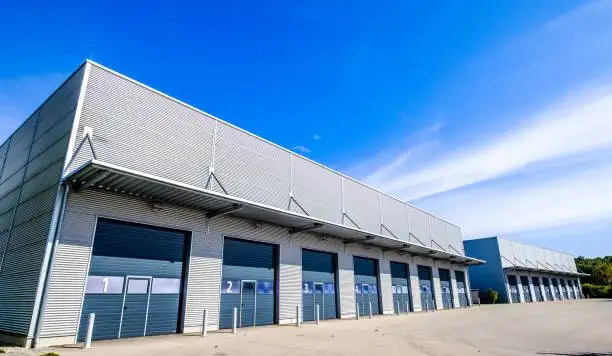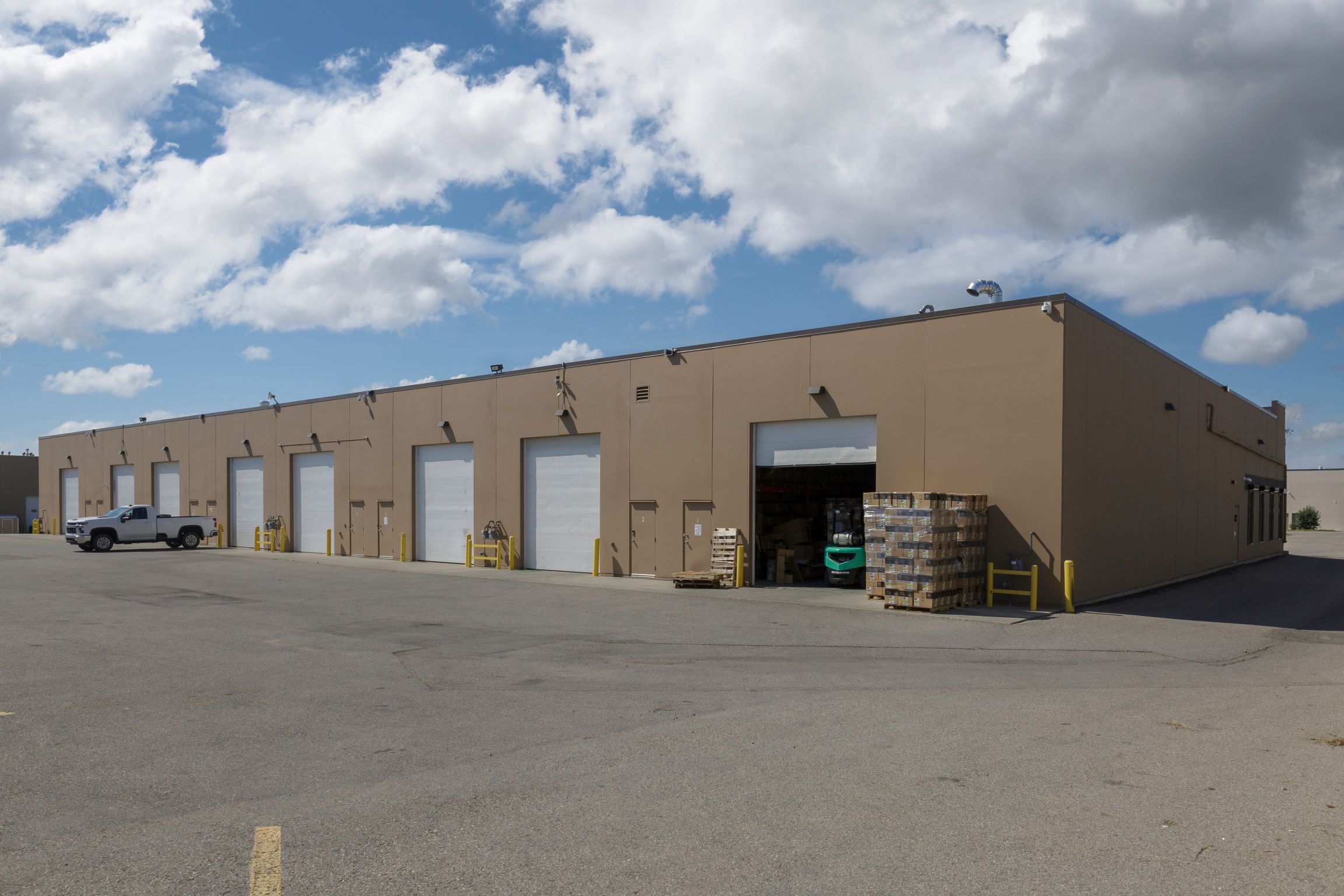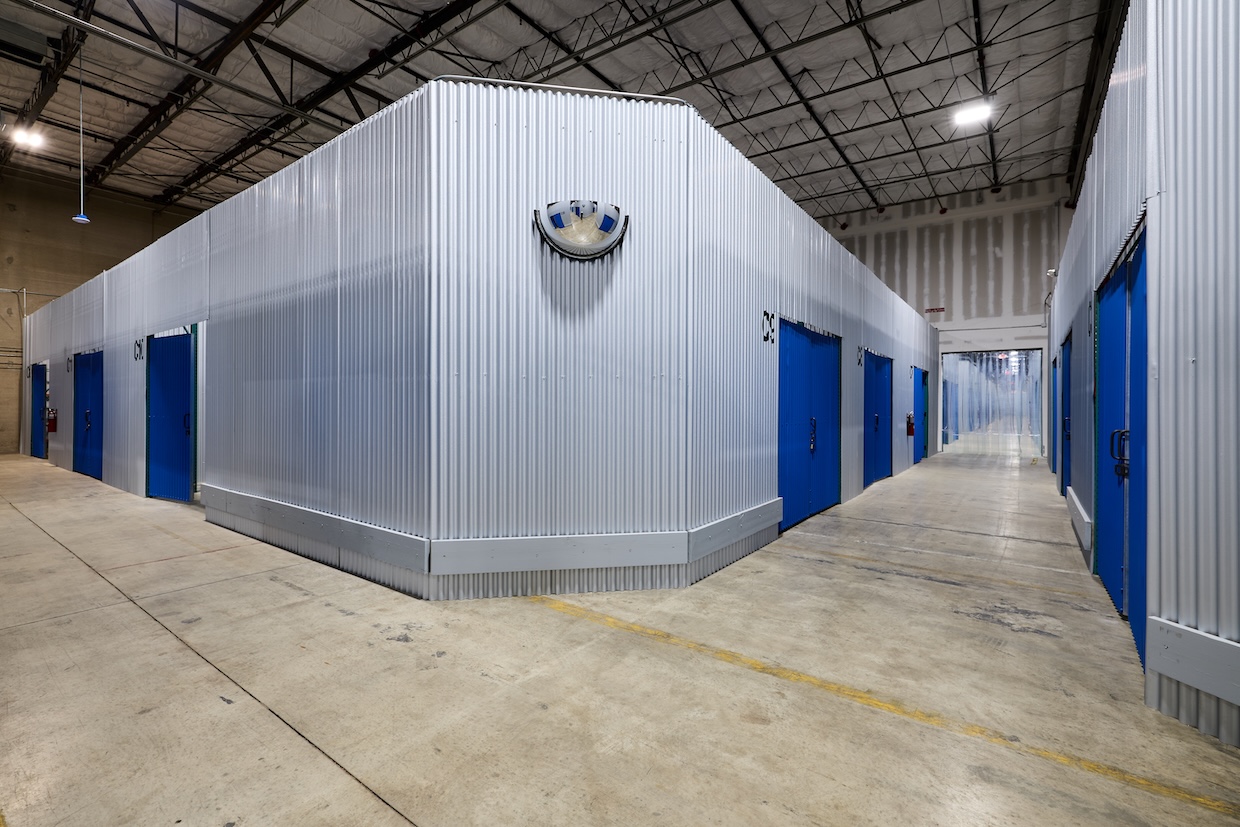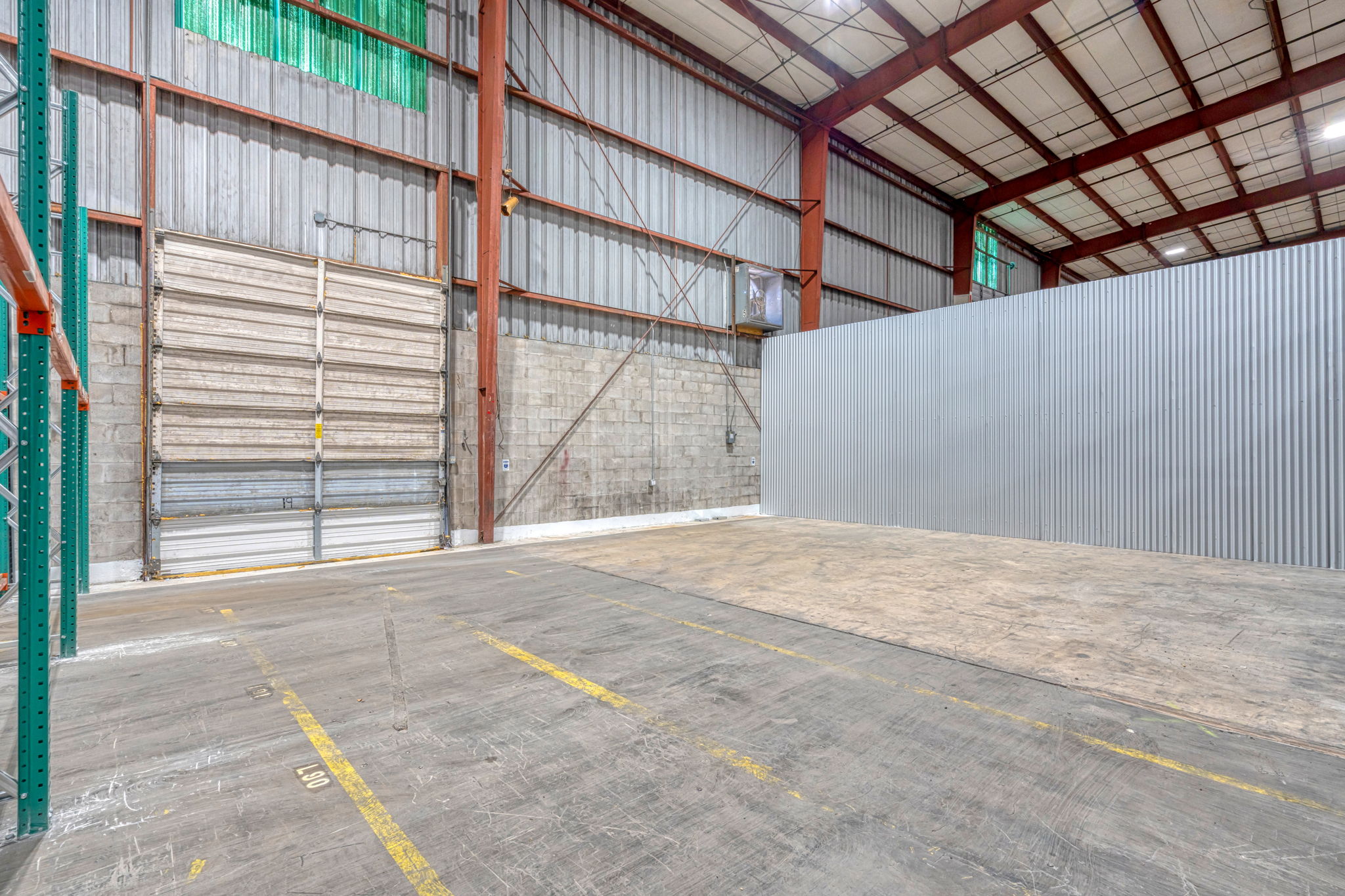Small Bay Industrial Guide: An In-depth Look At The Underdog of Industrial Real Estate
In an era dominated by massive distribution centers and million-square-foot fulfillment facilities, small bay industrial properties represent a fundamentally different approach to industrial real estate. With column spacing of 24 feet or less, these facilities weren’t designed for the pallet-in, pallet-out efficiency that defines modern logistics. Yet they continue to serve critical functions across manufacturing, last-mile delivery, flex space, and specialized operations.

Understanding the specifications, strengths, limitations, and ideal applications of small bay industrial properties is crucial for tenants seeking alternatives to modern big-box warehouses and for investors evaluating repositioning opportunities for older industrial buildings.
Defining Small Bay Industrial: Specifications and Characteristics
What is Bay Size?
Bay size refers to the distance between structural support columns in an industrial building, measured from the center of one column to the center of the next. This fundamental architectural specification determines virtually every operational consideration, from equipment maneuverability to racking configuration to workflow design.
Small bay industrial spaces feature column spacing of 24 feet or less. The most common configurations include:
- 20′ × 20′ – Tighter spacing is common in older urban facilities
- 24′ × 24′ – The upper range of small bay classification
- 20′ × 24′ or 24′ × 20′ – Rectangular bay configurations
These dimensions contrast sharply with modern mid-bay warehouses (28-36 feet spacing) and large bay facilities (40+ feet spacing), which were purpose-built for efficient palletized storage and modern material handling equipment.
Structural Characteristics
Clear Height Limitations: Clear ceiling heights in small bay facilities typically range from 14 to 20 feet, which is significantly lower than the standard 28- to 32-foot ceiling heights in modern warehouses. This vertical constraint directly limits cubic storage capacity and restricts the height of racking systems. While modern facilities can accommodate 3-4 levels of pallet racking, small bay buildings often reach their maximum capacity at 2-3 levels before hitting ceiling limitations.
Structural Systems: Small bay construction typically employs one of two structural approaches:
- Concrete tilt-up construction – Precast concrete panels for walls with steel columns and beam roof systems
- Steel frame construction – All-steel structural systems with masonry or metal panel exteriors
Both systems create a close column grid that defines small bay functionality. The columns aren’t merely structural necessities; they become defining features of how the space can be utilized.
Loading Infrastructure: Small bay facilities generally feature fewer dock doors per square foot compared to modern warehouses. Truck courts tend to be smaller and tighter, designed for the smaller delivery vehicles common decades ago rather than today’s 53-foot trailers. Many small bay properties rely on grade-level loading or limited dock positions, which impacts operational efficiency for distribution-intensive users.
The Operational Reality: How Column Spacing Impacts Function
Racking and Storage Density
The fundamental limitation of small bay industrial space is single-deep racking. With only 20-24 feet between columns, after accounting for:
- Racking depth (typically 42-48 inches front and back)
- Required forklift aisles (11-13 feet for counterbalance forklifts)
…there simply isn’t room for double-deep or triple-deep racking configurations that maximize cubic storage in modern warehouses.
This constraint means:
- Lower storage density per square foot compared to modern alternatives
- More aisle space relative to storage space (often 50-60% aisles vs. 30-40% in modern facilities)
- Higher cost per pallet stored when measured purely on storage efficiency
However, for operations that prioritize picking speed and accessibility over maximum density, single-deep racking can actually be advantageous, every pallet position is immediately accessible without moving other pallets.
Material Handling Equipment Considerations
Small bay column spacing creates specific equipment challenges and opportunities:
Counterbalance Forklifts: Traditional counterbalance forklifts require approximately 12-13 feet of aisle width for safe operation and turning. This works well in small bay spaces, but it consumes a significant percentage of the floor area. The tight column grid also means operators must execute more careful maneuvers when navigating bays.
Reach Trucks: Reach trucks, which require only 9-10 feet of aisle width in mid-bay facilities, offer marginal benefits in small bay environments. The columns still constrain layout flexibility, and the cost of reach trucks may not justify the modest space savings.
Turret Trucks and Very Narrow Aisle (VNA) Equipment: These advanced systems, which can operate in aisles as narrow as 6-7 feet, are generally incompatible with small bay facilities. The close column spacing prevents the long, uninterrupted racking runs these systems require, and the lower ceiling heights don’t justify the investment in specialized equipment.
Pallet Jacks and Manual Handling: For many small bay operations, traditional pallet jacks and manual material handling are the most economical solution. If volumes don’t justify powered equipment, the human-scale proportions of small bay facilities can actually work well.
Workflow and Layout Design
Small bay architecture naturally compartmentalizes space. Rather than fighting this limitation, successful small bay tenants embrace it:
Cell-Based Manufacturing: The column grid provides natural divisions for production cells, quality control areas, and subassembly stations. Each bay can be assigned specific functions without the need for artificial barriers.
Zone-Based Storage: For warehousing operations, columns can define product zones, customer sections in 3PL operations, or staging areas. While this creates more complexity than open-plan warehouses, it can facilitate organization and inventory control.
Traffic Flow Patterns: Tight column spacing requires more deliberate traffic flow design. One-way aisles, clearly marked forklift paths, and dedicated receiving/shipping areas become more critical when columns restrict movement options.
Ideal Applications: Where Small Bay Industrial Excels
Despite limitations for modern distribution, small bay industrial properties thrive in specific applications where their characteristics become advantages.
Manufacturing and Light Assembly Operations
Small bay facilities were designed for manufacturing, and this remains their strongest use case. The structural characteristics that limit warehousing efficiency actually support production operations:
Overhead Crane Systems: The closer column spacing reduces the span that overhead cranes must cover, lowering installation costs and allowing lighter-duty crane systems. A 20-foot crane span is significantly less expensive and easier to engineer than a 50-foot span, making small bay facilities economically attractive for operations requiring material lifting.
Production Cell Layout: Manufacturing operations are often organized into discrete production cells or assembly stations.
The bay structure naturally defines these areas, providing:
- Clear spatial divisions between different production processes
- Natural locations for tool cribs, QC stations, and material staging
- Easier implementation of lean manufacturing principles (5S, kanban systems)
- Visual management—each bay’s function is immediately apparent
Utilities and Services: Small bay buildings often feature more robust electrical service and compressed air distribution than pure warehouse space. The manufacturing heritage means that the infrastructure was designed for equipment loads, welding operations, and production machinery, rather than just lighting and HVAC.
Examples:
- Machine shops and metal fabrication
- Electronics assembly and testing
- Food production and packaging
- Pharmaceutical compounding
- Prototype development and R&D manufacturing
Last-Mile Delivery and Urban Distribution
The rise of e-commerce and demand for rapid delivery has created unexpected value in small bay industrial properties, particularly those in urban infill locations.
Location Premium: Small bay facilities often occupy urban sites close to dense consumer populations. For last-mile delivery operations, proximity to customers often outweighs concerns about storage efficiency. A facility located 5 miles from delivery zones may be far more valuable than a modern warehouse 25 miles away, despite having a lower cubic capacity.
Micro-Fulfillment Centers: E-commerce companies are increasingly deploying networks of smaller urban fulfillment points, rather than relying solely on regional mega-warehouses. Small bay facilities with 15,000-40,000 square feet serve these micro-fulfillment strategies effectively:
- Holding high-velocity SKUs for same-day or 2-hour delivery
- Serving as staging points where goods break bulk from larger facilities
- Supporting local delivery services, meal kit delivery, and grocery fulfillment
- Accommodating last-mile delivery vehicle fleets (vans and small box trucks vs. 53′ trailers)
Parcel Delivery Hubs: Major carriers (UPS, FedEx, Amazon Logistics) increasingly seek smaller urban distribution points. Small bay facilities work well for:
- Package sorting and route loading
- Delivery driver marshalling areas
- Temporary surge capacity during peak seasons
- Returns processing and consolidation
Operational Adaptation: Last-mile tenants typically accept lower storage density because:
- Inventory turns multiple times daily (high velocity reduces storage needs)
- Route optimization software maximizes the value of urban locations
- Speed to the customer is the primary competitive advantage
- Labor pools are more accessible in urban areas
Flex Space and Office-Warehouse Combinations
Small bay industrial properties excel as flex space facilities that combine office, showroom, and warehouse functions, particularly for businesses requiring more office space than pure warehousing operations.
Office Conversion: The lower ceiling heights in small bay buildings (14-20 feet) are more suitable for office conversion than those in 32-foot clear warehouses. Creating mezzanine offices, conference rooms, and finished spaces is more economical and comfortable in human-scale buildings.
Finished Interior Standards: Small bay facilities often feature better HVAC systems, finished walls, and improved lighting compared to utilitarian warehouse shells, reducing tenant improvement costs for mixed-use operations.
Ideal Flex Tenants:
- Technology companies needing demonstration space, assembly areas, and office
- Contractors and distributors requiring showrooms, customer areas, and material storage
- Architecture and design firms with sample libraries and workshop spaces
- Professional services with storage needs (law firms, medical records, media companies)
- Creative businesses blending production and office functions
Space Ratios: Flex tenants typically deploy 30-60% of square footage as office/showroom, with the remainder as warehouse/production. This ratio makes efficient use of small bay properties where pure warehousing would be suboptimal.
Specialized Storage and Distribution
Certain storage operations actually benefit from small bay configurations, particularly those handling non-palletized inventory or requiring compartmentalized storage.
Auto Parts Distribution: Automotive aftermarket parts rarely ship on full pallets. Small bay facilities accommodate:
- Bin shelving and multi-tier shelving systems
- Zone-based organization by vehicle make/model
- Will-call counter operations serving professional installers
- Multiple small orders vs. full-pallet movements
Records Management and Document Storage: Small bay buildings serve document storage providers well:
- High-density shelving systems don’t require wide column spacing
- Multiple levels of storage maximize vertical space
- Climate control is easier in smaller-bay buildings
- Individual customer storage zones fit naturally into the bay structure
Medical and Pharmaceutical Distribution: Healthcare products often require:
- Segregated storage zones (by client, product type, or security level)
- Controlled access and visibility between zones
- Lower cubic volumes with high value
- Temperature-controlled environments (easier in smaller volumes)
Electronics and High-Value Goods: Small bay facilities support secure storage of electronics, IT equipment, and high-value items:
- Compartmentalized security zones
- Reduced sight lines prevent a visual inventory of the entire facility
- Smaller individual spaces for multi-tenant high-security storage
Service and Repair Operations
Small bay column spacing naturally defines work bays for service-intensive industrial tenants:
Equipment Repair and Refurbishment:
- Forklift and material handling equipment repair
- Commercial equipment refurbishment
- Restaurant equipment service
- Medical equipment servicing
Vehicle Maintenance: Small bay facilities serve fleet maintenance, specialty vehicle work, and commercial equipment service, where each bay becomes a defined work zone.
Contractor Operations: Electrical, plumbing, HVAC, and other contractors use small bay space effectively for:
- Tool and equipment storage
- Vehicle parking and maintenance
- Material staging and job preparation
- Administrative and dispatch functions
Artisan Production and Maker Spaces
The neighborhood locations and human-scale proportions of small bay buildings appeal to creative industrial users:
Craftspeople and Small Manufacturers:
- Woodworking and furniture making
- Metal fabrication and artistic metalwork
- Small-batch food production (craft beverages, specialty foods)
- Textile production and garment manufacturing
- Bicycle assembly and custom builders
Maker Spaces and Co-Working: Small bay buildings convert well into shared maker spaces offering:
- Individual work bays for craftspeople
- Shared equipment areas (CNC machines, laser cutters, industrial sewing)
- Storage for materials and projects
- Community spaces in higher-finish areas
Financial Considerations: The Economics of Small Bay
Understanding the financial realities of small bay industrial space requires looking beyond simple rent-per-square-foot metrics.
Rental Rates
Small bay industrial space typically commands $0.40-0.65 per square foot per month in most U.S. markets, though rates vary significantly by location:
Urban Premium Markets: In constrained urban markets (Brooklyn, San Francisco, Seattle, Portland), small bay spaces can command $1.00-$1.50/SF/month due to their location value and limited supply.
Suburban Secondary Markets: In suburban locations competing with modern mid-bay and large bay facilities, small bay properties often sit at the bottom of the rental curve, offering value-conscious tenants cost savings.
Discount to Modern Product: Where comparable modern industrial space rents for $0.75-$ 1.00/SF/month, small bay facilities typically sit 30-40% below market to compensate for their functional limitations.
True Occupancy Costs
Evaluating small bay economics requires understanding total occupancy costs:
Operating Expenses: Older small bay buildings often carry higher operating expenses:
- Outdated HVAC systems with lower efficiency
- Older lighting (unless retrofitted to LED)
- Higher maintenance costs for aging systems
- Less efficient building envelopes (lower R-value insulation)
Tenant Improvements: Small bay properties may require significant tenant improvements:
- Racking systems must be engineered around columns
- Lighting upgrades (many still have old fluorescent systems)
- Fire suppression upgrades for modern occupancy
- Dock door additions or modifications
- Power upgrades for modern equipment
Efficiency Metrics: When calculating cost-per-pallet stored or cost-per-unit shipped, small bay facilities often appear expensive compared to modern alternatives. However, when location value, flexibility, or specialized use requirements factor in, total economic analysis may favor a small bay.
Investment and Repositioning
For industrial real estate investors, small bay properties present specific opportunities and challenges:
Value-Add Repositioning: Small bay buildings often trade at significant discounts to replacement cost, creating value-add opportunities:
- Converting to flex space with office build-outs
- Upgrading to attract last-mile delivery tenants
- Subdividing for multi-tenant users
- Repositioning from industrial to alternative uses (creative office, retail, self-storage)
Obsolescence Risk: Small bay properties face functional obsolescence risk in markets with abundant modern supply. However, strategic locations (urban infill, last-mile proximity) provide protection against value erosion.
Adaptive Reuse: Many small bay industrial buildings ultimately transition to non-industrial uses:
- Self-storage conversion
- Creative office space
- Retail/showroom space
- Brewery/restaurant venues
- Residential conversion (in select high-value locations)
Evaluating Small Bay Space: Key Questions for Tenants
If you’re considering small bay industrial space, these questions help determine suitability:
1. Does Your Operation Prioritize Location Over Efficiency?
If proximity to customers, labor, or urban amenities is critical, small bay facilities in infill locations may deliver more value than distant modern warehouses despite storage inefficiencies.
2. Is Your Inventory Suited to Single-Deep Racking?
High-velocity inventory, non-palletized goods, or operations requiring frequent access to all SKUs can work effectively with single-deep racking. If you need maximum cubic density for slow-moving inventory, small bay won’t optimize costs.
3. What Material Handling Equipment Do You Use?
If your operation relies on manual handling, pallet jacks, or basic counterbalance forklifts, small bay works. If you require reach trucks, turret trucks, or automated systems, mid-bay or large bay facilities will deliver better ROI.
4. Does Your Operation Benefit from Compartmentalized Space?
Manufacturing cells, multi-client 3PL operations, or businesses requiring segregated work zones may find the bay structure advantageous rather than limiting.
5. Is Your Building Use Mixed (Office/Warehouse)?
If you require substantial office space (exceeding 25% of the total area), small bay buildings with lower ceilings and better finishes often offer more favorable economics than converting high-bay warehouse space.
6. Do You Need Overhead Lifting Capability?
If your operation requires overhead cranes or hoists, small bay facilities offer installation cost advantages due to shorter span requirements.
7. What’s Your Growth Trajectory?
If you anticipate rapid growth in storage needs, starting in a small bay space may create expensive relocation requirements. If your footprint is stable or you’re consolidating, a small bay may be a suitable long-term solution.
Understanding Alternatives: Mid-Bay and Large Bay (Brief Overview)
While this guide focuses on small bay industrial, understanding alternatives helps contextualize when small bay makes sense.
Mid-Bay Warehouses (28-36′ spacing) represent the current construction standard for Class A industrial buildings. These facilities offer double-deep racking, good equipment maneuverability, and serve the broadest range of users, including 3PL operators, regional distributors, and e-commerce fulfillment centers. Mid-bay facilities typically rent for $0.55-$ 0.85/SF/month and provide the balanced functionality that most tenants seek.
Large Bay Warehouses (40’+ spacing) deliver maximum storage efficiency with triple-deep or greater racking, very narrow aisle capability, and optimal automation accommodation. These facilities command premium rents ($0.75-1.20+/SF/month) but maximize cubic utilization for major distribution centers, cold storage, and automated fulfillment operations.
For most warehousing-intensive operations, mid-bay or large bay facilities will deliver superior operational efficiency. Small bay properties succeed where location, specialized use, or manufacturing requirements take precedence over pure storage efficiency concerns.
The Future of Small Bay Industrial
Despite decades of predictions about small bay obsolescence, these properties maintain relevance in evolving industrial real estate markets:
Urban Densification Trends
As cities restrict outward sprawl and prioritize infill development, small bay properties in established industrial zones gain value. Last-mile delivery requirements ensure continued demand for urban industrial space, even if inefficient by traditional metrics.
Manufacturing Reshoring
Supply chain disruptions and reshoring initiatives are revitalizing domestic manufacturing. Small bay facilities, purpose-built for production, serve this trend well, particularly for smaller manufacturers who cannot justify the cost of purpose-built facilities.
Mixed-Use Evolution
Progressive zoning increasingly allows industrial uses in mixed-use developments. Small bay properties integrate more successfully into these environments than massive warehouses, supporting the “15-minute city” concept, which requires proximate production and distribution.
Adaptive Reuse Innovation
Creative developers continue to find new uses for small bay buildings—from food halls to maker spaces to experiential retail—extending their useful life well beyond their original industrial purposes.
Key Takeaways
Small bay industrial properties (with ≤24′ column spacing) serve distinct market niches, despite limitations for modern warehousing. These facilities excel in:
- Manufacturing and production operations benefit from compartmentalized space
- Last-mile delivery where urban location trumps storage efficiency
- Flex space applications requiring office-warehouse integration
- Specialized storage with non-palletized inventory
- Service operations utilizing natural bay divisions
While modern mid-bay and large-bay facilities deliver superior efficiency for pure warehousing, small-bay properties offer economic advantages for location-sensitive, manufacturing-intensive, or specialized operations. Success with small bay space requires understanding both its constraints and its unique advantages, then matching property characteristics to operational requirements.
Searching for small bay industrial space for manufacturing, last-mile, or specialized operations? WareCRE’s marketplace includes small bay properties alongside modern mid-bay and large bay facilities across all markets. Search available listings or contact our industrial specialists to discuss your specific requirements.


